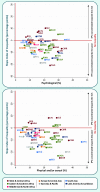Intimate partner violence in 46 low-income and middle-income countries: an appraisal of the most vulnerable groups of women using national health surveys
- PMID: 32133178
- PMCID: PMC7042580
- DOI: 10.1136/bmjgh-2019-002208
Intimate partner violence in 46 low-income and middle-income countries: an appraisal of the most vulnerable groups of women using national health surveys
Abstract
Introduction: Intimate partner violence (IPV) against women is a critical public health issue that transcends social and economic boundaries and considered to be a major obstacle to the progress towards the 2030 women, children and adolescents' health goals in low-income and middle-income countries (LMICs). Standardised IPV measures have been increasingly incorporated into Demographic and Health Surveys carried out in LMICs. Routine reporting and disaggregated analyses at country level are essential to identify populational subgroups that are particularly vulnerable to IPV exposure.
Methods: We examined data from 46 countries with surveys carried out between 2010 and 2017 to assess the prevalence and inequalities in recent psychological, physical and sexual IPV among ever-partnered women aged 15-49 years. Inequalities were assessed by disaggregating the data according to household wealth, women's age, women's empowerment level, polygyny status of the relationship and area of residence.
Results: National levels of reported IPV varied widely across countries-from less than 5% in Armenia and Comoros to more than 40% in Afghanistan. Huge inequalities within countries were also observed. Generally, richer and more empowered women reported less IPV, as well as those whose partners had no cowives. Different patterns across countries were observed according to women's age and area of residence but in most cases younger women and those living in rural areas tend to be more exposed to IPV.
Conclusion: The present study advances the current knowledge by providing a global panorama of the prevalence of different forms of IPV across LMICs, helping the identification of the most vulnerable groups of women and for future monitoring of leaving no one behind towards achieving the elimination of all forms of violence among women and girls.
Keywords: community-based survey; epidemiology; public health.
© Author(s) (or their employer(s)) 2020. Re-use permitted under CC BY. Published by BMJ.
Conflict of interest statement
Competing interests: None declared.
Figures




Similar articles
-
Intimate partner violence against adolescents and young women in sub-Saharan Africa: who is most vulnerable?Reprod Health. 2021 Jun 17;18(Suppl 1):119. doi: 10.1186/s12978-021-01077-z. Reprod Health. 2021. PMID: 34134704 Free PMC article.
-
Women's and men's reports of past-year prevalence of intimate partner violence and rape and women's risk factors for intimate partner violence: A multicountry cross-sectional study in Asia and the Pacific.PLoS Med. 2017 Sep 5;14(9):e1002381. doi: 10.1371/journal.pmed.1002381. eCollection 2017 Sep. PLoS Med. 2017. PMID: 28873087 Free PMC article.
-
Economic empowerment and intimate partner violence: a secondary data analysis of the cross-sectional Demographic Health Surveys in Sub-Saharan Africa.BMC Womens Health. 2021 Jun 12;21(1):241. doi: 10.1186/s12905-021-01363-9. BMC Womens Health. 2021. PMID: 34118922 Free PMC article.
-
Prevalence of intimate partner violence against women in the Arab world: a systematic review.BMC Int Health Hum Rights. 2019 Oct 22;19(1):29. doi: 10.1186/s12914-019-0215-5. BMC Int Health Hum Rights. 2019. PMID: 31640716 Free PMC article.
-
Prevalence of intimate partner violence against infertile women in low-income and middle-income countries: a systematic review and meta-analysis.Lancet Glob Health. 2022 Jun;10(6):e820-e830. doi: 10.1016/S2214-109X(22)00098-5. Lancet Glob Health. 2022. PMID: 35561719 Free PMC article.
Cited by
-
Displacement, Polygyny, Romantic Jealousy, and Intimate Partner Violence: A Qualitative Study among Somali Refugees in Ethiopia.Int J Environ Res Public Health. 2022 May 9;19(9):5757. doi: 10.3390/ijerph19095757. Int J Environ Res Public Health. 2022. PMID: 35565149 Free PMC article.
-
Intimate Partner Violence and Pregnancy Termination in Armenia: Evidence from Nationally-Representative Survey Data.Eur J Investig Health Psychol Educ. 2021 Mar 28;11(2):294-302. doi: 10.3390/ejihpe11020022. Eur J Investig Health Psychol Educ. 2021. PMID: 34708813 Free PMC article.
-
Applying technology to promote sexual and reproductive health and prevent gender based violence for adolescents in low and middle-income countries: digital health strategies synthesis from an umbrella review.BMC Health Serv Res. 2022 Nov 19;22(1):1373. doi: 10.1186/s12913-022-08673-0. BMC Health Serv Res. 2022. PMID: 36401323 Free PMC article.
-
Afghan mental health and psychosocial well-being: thematic review of four decades of research and interventions.BJPsych Open. 2023 Jul 10;9(4):e125. doi: 10.1192/bjo.2023.502. BJPsych Open. 2023. PMID: 37424447 Free PMC article. Review.
-
Intimate partner violence with vaginal insertion of a partial chili pod (Capsicum annuum): A case report.Clin Case Rep. 2022 Apr 15;10(4):e05749. doi: 10.1002/ccr3.5749. eCollection 2022 Apr. Clin Case Rep. 2022. PMID: 35441017 Free PMC article.
References
-
- Daher M. World report on violence and health. J Med Liban 2003;51:59–63. - PubMed
-
- World Health Organization Global and regional estimates of violence against women: prevalence and health effects of intimate partner violence and non-partner sexual violence. 2013, 2013: 57.
Publication types
MeSH terms
Grants and funding
LinkOut - more resources
Full Text Sources
Medical
